Teutonic Refinement Meet Yankee Brown
World War II changed most everything about planet earth. Society, culture, industry, and politics all underwent a seismic shift during this worldwide conflict that ultimately claimed 50 million souls. This most horrible of wars spilt rivers of blood.
Previously gunmaking retained some modicum of art. Military weapons combined the machinist’s touch with the woodworker’s skill to produce weapons that were elegant, graceful, and expensive. Receivers typically began life as huge chunks of forged steel before being cut or turned into something mechanically complex, sometimes on machines still driven by steam. In the desperate fight for national survival that defined World War II, however, man perfected the mass production of his implements of destruction.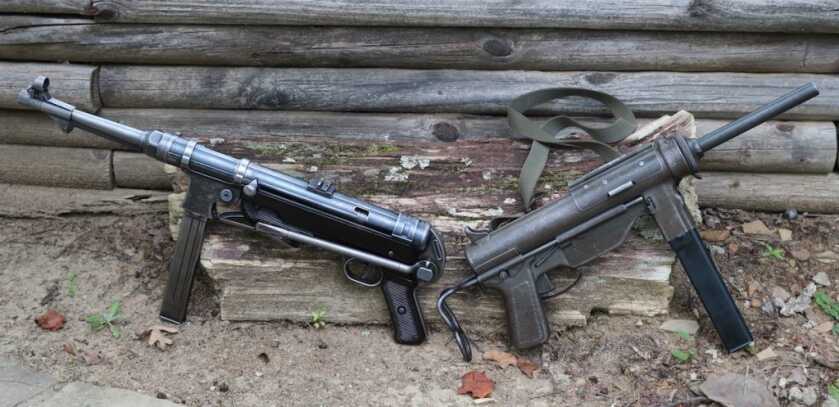
MP40 M3A1 Grease Gun
- Weight. 8.75 lbs 7.95 lbs
- Length—Stock Extended 32.8 in 29.8 in
- Length—Stock Retracted 24.8 22.8 in
- Barrel Length 9.9 in 8 in
- Cartridge 9mm .45 ACP
- Muzzle velocity 1,300 feet/second 920 feet/second
- Rate of Fire 500 rounds/minute 450 rounds/minute
- Sights Fixed Fixed
- Total wartime Production 1.1 million 700,000
German Origins
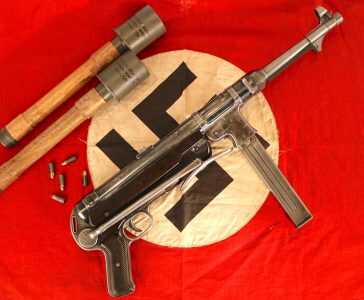 The MP38 was cut from a heavy steel tube and can be readily identified by the longitudinal grooves cut in the receiver. The MP38 also has a dime-sized lightening hole stamped into both sides of the magazine well. Otherwise, the MP38 incorporated stamped steel fire controls, sights, and ancillary widgets. The gun also eschewed the use of wood anywhere in its production.
The MP38 was cut from a heavy steel tube and can be readily identified by the longitudinal grooves cut in the receiver. The MP38 also has a dime-sized lightening hole stamped into both sides of the magazine well. Otherwise, the MP38 incorporated stamped steel fire controls, sights, and ancillary widgets. The gun also eschewed the use of wood anywhere in its production.
The MP38 was initially intended for use within and around armored vehicles. As a result, a synthetic polymer barrel rest was included underneath the barrel. The hook on the end of the rest was designed to rest outside the armor of a halftrack such that the muzzle didn’t inadvertently wander into the crew compartment under recoil.
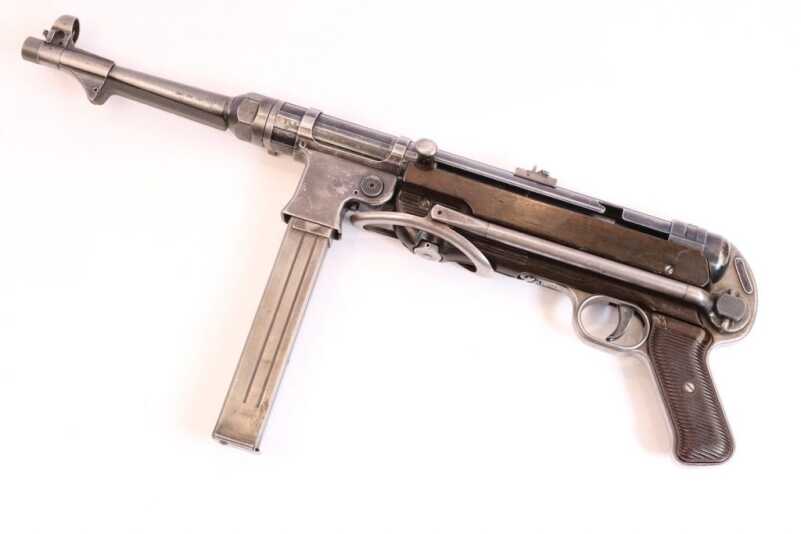
The German MP40 submachine gun ushered in an entirely new era in military gun building. Sporting stamped steel components and a collapsible stock, the MP40 was the world’s first martial weapon truly optimized for mass production.
The MP38 rendered superb service in the hands of German Fallschirmjagers during their parachute assaults into Norway, Poland and Belgium. This tidy little submachine gun also armed German Panzer troops on their Blitzkrieg across Europe early in the war. Despite its incorporation of advanced production techniques, the Germans still saw room for improvement.
The MP40
The primary difference between the MP38 and the subsequent MP40 rested in the production of the receiver. The receiver of the MP40 was pressed out of thin gauge sheet steel on industrial presses. As a result, the gun could be produced en masse by semi-skilled labor. Production of the MP40 continued until the MP44 assault rifle supplanted it. Around 1.1 million of these guns were ultimately produced.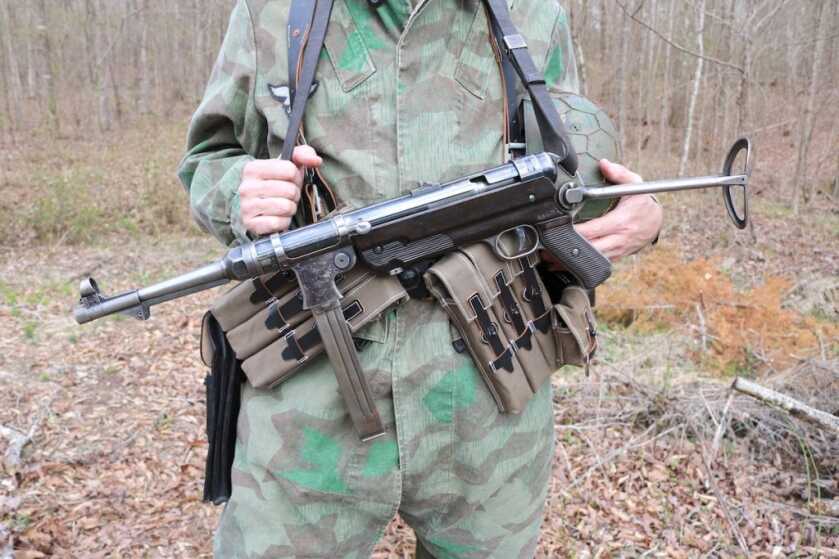

The folding steel stock on the MP40 was a bit flimsy yet remained effective under hard use. The pivoting buttplate must be folded flat when stowed.
The MP40 fed from a double column 32-round box magazine that tapered to a single feed for presentation. While offering reliable feed geometry, this design was prone to stoppage when dirty and required a magazine loading tool to load. The gun also incorporated a unique recoil assembly wherein nested steel cups telescoped into themselves around the recoil spring. This gave the MP40 an unusually smooth firing cycle. When combined with the weapon’s sedate rate of fire and front-heavy design this made the gun imminently controllable. The weapon was fully automatic only.
The original MP38 and early MP40s lacked a manual safety beyond a cutout to lock the bolt to the rear. However, the gun could be dropped onto its butt with a loaded magazine in place and suffer an accidental discharge. In this circumstance, the bolt might drop back far enough to pick up a round but not far enough to engage the sear. The fix for this problem involved cutting a locking slot in the front of the receiver and replacing the bolt with an improved version. The new charging handle could be snapped in place to secure the bolt in the forward position. Until the fix could be updated the Germans issued a special leather strap that would lock the bolt in place externally.

The Nazis serialized everything on their weapons to include the firing pin and these early Bakelite grip plates.
Despite the streamlined nature of the MP40 the Germans just couldn’t bring themselves to let go of their compulsive gunmaking proclivities. As a result, the MP40 is simply festooned with waffenamt acceptance stamps and every part big enough to accept one sports a serial number, to include the firing pin. This does indeed make for an elegant firearm that likely inspired confidence in its users, but did not lend itself to mass production by an industry threatened both day and night by Allied bombing. The MP40 has been encountered in action as recently as the Syrian Civil War.
The American Buzzgun
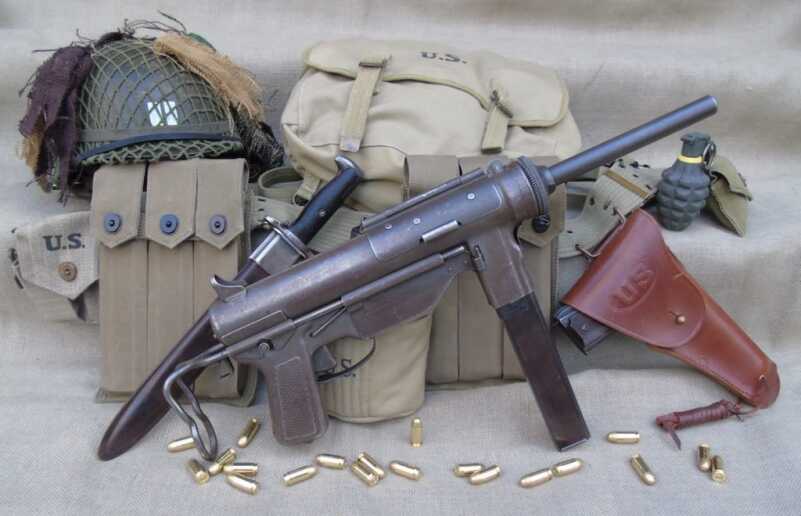
The American M3A1 Grease Gun was as utilitarian as we could make it. Sporting stamped steel for most of its components, the Grease Gun was ultimately a remarkably effective service weapon.
World War II was a come-as-you-are affair for the United States, and we found ourselves woefully unprepared when Pearl Harbor finally dragged us kicking and screaming into war. Our issue submachine gun of the day was the 1928A1 Thompson, but it was obsolete before the first bomb fell on that fateful Sunday morning. However, we Americans are a hearty lot and we responded by doing what we do best. We banded together, rolled up our sleeves, and built stuff.
The M1928 morphed into the somewhat simplified M1A1 Thompson that was a bit easier and cheaper to build. Around 1.5 million Tommy guns rolled off the lines during the war to equip Allied forces of all nationalities. Even while we were ramping up to build Thompsons by the hundreds of thousands the War Department was rushing to secure a low-cost replacement.
The Thompson was sinfully heavy. With a loaded 50-round drum in place it weighed nearly what a Browning Automatic Rifle (BAR) might. It was also mechanically complicated and suffered simply dreadful ergonomics. Despite its shortcomings, however, American GIs loved the gun. Many to most of them had cut their teeth on Saturday afternoon crime serials and going to war with a gangster chopper held an allure. The replacement for the Thompson was as unlike this big pre-war gun as might possibly be imagined.
The Grease Gun
The M3 Grease Gun was first adopted for service just over a year after the Pearl Harbor attack. In stark contrast to the Thompson, the M3 was simple, ugly, and utilitarian. The receiver was comprised of two halves of sheet steel welded together to form a shell. The bolt rode loosely within this assembly on a pair of guide rods. This allowed the gun to function in the face of modest damage. The sliding stock was formed from heavy gauge steel wire. In the original M3 version a ratcheting lever on the right side of the gun actuated the bolt. Everything that could be produced via industrial stampings was produced via industrial stampings. When compared to the elegant and meticulously built Thompson the M3 was positively homely.
The charging handle of the M3 was found to be unduly flimsy and the unfenced magazine release allowed the magazine to be dropped inadvertently. As a result, the improved M3A1 added a raised steel fence around the magazine release and dispensed with the ratcheting charging handle entirely. In its place was a simple divot in the bolt that allowed the operator to retract the bolt with a standard finger.
The Grease Gun weighed around 8 pounds and fed from the same sort of double column, single feed magazine that drove the MP40. In the M3A1 version the wire stock incorporated a useful and effective magazine loading tool. A large stamped steel dust cover folded in place to occlude battlefield grunge. A steel tab on this appendage locked the bolt and served as the gun’s sole safety. The gun’s heavy bolt and long travel conspired to yield a rate of fire of around 450 rounds per minute.
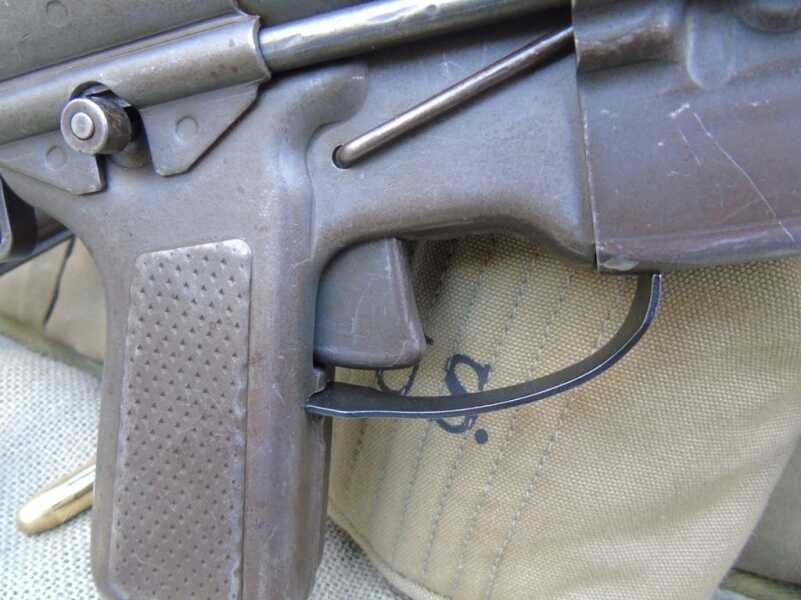
The trigger and receiver-cum-pistol grip were all formed from stamped steel. The trigger guard was a simple length of spring steel.
The Grease Gun cost $15 to make in 1943 (around $215 today) and was quite literally disposable. The Army supply system did not stock spare parts. When a Grease Gun went down it was discarded. There was a field modification of early M3 models that involved milling a slot in the receiver for a steel charging handle that reciprocated with the bolt for use when the ratchet system failed.
The first recorded combat use of the Grease Gun was on the Airborne drop in support of D-Day. While GIs distrusted the Greaser early on for its crude appearance, most ultimately expressed grudging admiration for the design. The gun was profoundly robust and thoroughly reliable. The improved M3A1 version briefly saw action in the closing weeks of the war. The Grease Gun was used through the Korean War and Vietnam War all the way up to the Gulf War. I encountered high mileage World War II-vintage M3A1 Grease Guns in the hands of U.S. Army tankers while I was on active duty in the 1990s.
Face Off
Both these guns are bulky. The left-sided nature of the charging handle on the MP40 means the sling must be arranged on the right. This makes the gun a bit more awkward to tote. The Grease Gun uses a standard canvas M1 Carbine sling, while the MP40 employs an adjustable leather version. The MP40 sights are flip adjustable for 100 and 200 meters while the Grease Gun’s are simply fixed, but they are comparably effective.
The two guns sport very different personalities, but I found that I could keep my rounds on target with a comparable facility with both guns. The big .45ACP bullets are fully twice as heavy as the 9mm rounds the MP40 fires, so they bring markedly more horsepower. Both weapons enjoy a sedate rate of fire so singles and doubles are easy with a disciplined trigger finger.
The MP40 and the M3A1 Grease Gun were birthed under utterly different circumstances. One nation wanted to enslave the world. The other wanted to free it. That these guns share so many similar morphological characteristics is intriguing. These days rifle-caliber carbines have displaced the submachine gun in the arsenals of most developed countries. However, for a time, these two stamped steel submachine guns slugged it out to determine the mastery of the world.
For more information about period gear used as support in this article, click here.
To purchase a military firearms on GunsAmerica, click here.



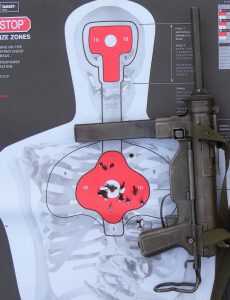

There was never a a showdown between the MP40 and the M3A1 Grease Gun.
This is because the only version of the Grease Gun that saw combat in Europe was the M3 (not M3A1).
Therefore, there was never any rivalary between these two subguns. The M3A1 was released too late in the
European Theatre and any combat was restricted to the Pacific (and even that was minimal).
America wanted to free the world! Hilarious! Good article though
My best friend has a m3a1 grease gun. With the stamps on it. He cant own it now . plus he is in california so he is putting up for sale. I told him it belongs at a museum. But he needs thr money. If anyone is interested contact me and ill pass it on to you. Responsible people only. Its one of a kind….
Love that Grease Gun. It just kinda hangs there & chugs. The Thompson . . . not so much.
Had one on my tank in the mid-60\’s in Germany. Never got to even fire it though, sad. I liked the feel, weight, and simplicity.
My dad trained with an M1 and an M3 for the bay of pigs invasion, during which he primarily used the M3. His training was to aim at the left toe, and let recoil walk the rounds across the target. A few hits with the 45s, and the target died. He contrasted that with Castro’s forces that had CZ27s in 7.62×25 which did not always disable those hit with it.
RIP Ernie A
2506 Brigade member
Great article. Good info. Also, thanks to all the great individuals who used these weapons doing the good work. You recollections are much appreciated.
My father carried an M3 in Korea, he had learned to hate the M1 for it’s size and weight.
He told me he found that as a Sargent he spent more time directing his boys fire than shooting himself, so the M3 suited him better.
When I qualified to purchase an M1 through the CMP, he had a cow.
“What in hell possessed you to buy that P.O.S.?” he asked me.
I never realized how much he disliked the Garand.
While our dad’s fought in the same hell they were opposite in gun tastes.my dad used a m3 when ammo hauling he didn’t hate the m3 but he couldn’t wait to replace it with a garand.he found a discarded M1 and scrounged a gas plug.perhaps your pop discarded my pops rifle?
Dad was magic with a rifle.me not so much but I’m ok with my pistols.
Tommygun851 says, I know most machine guns are designed to fire from an open bolt to help minimize recoil and make it more controllable.
WRONG! Firing from an open bolt not only does not reduce recoil, it kills accuracy AKA controllability.
The gun jumps before it’s fired when the bolt is released.
The whole open bolt on fully automatic guns is so that a round does not cook off in the red hot chamber.
Where do you get your name from?
I’ve been fortunate NFA owner of a German Styr 1943 Mp40 submachine gun since the early 90s and used it often for competitive National Firearm Association and Knob Creek Range subgun matches. I’ve shot several friends M3A1 and the Mp40 has an telescoping recoil spring and bolt travel distance advantage over the M3A1.
The Mp40 is one of the few submachine gun designs not allowing the bolt to bottom out on receiver or fulling collapsing and completely compressing recoil spring system which eliminates additional recoil and muzzle raise found in most open bolt submachine guns. That’s why the Mp40 is designed with elongated receiver preventing bolt hitting rear of receiver.
The bolt to sear engagement tab protrudes below all bolt surfaces eliminating possible sear drag and results lighter smooth trigger brake compared to every open bolt submachine gun I own as well as dozens of different types of submachine guns I’ve shot over the years. Also Mp40 barrel quality is unmatched for durability and most important accuracy out to 200 meters. Barrel rifling is extremely aggressive and manufactured to the highest tolerances, especially considering war time production. Sandbags and bench top steady it easy to hit 6″ round steel targets at 200 meters regardless not practical range for 9mm caliber, but Mp40 retains the ability in comparison.
By no means am I knocking the American classic M3A1, but rarely have I seen a M3A1 out perform the Mp40 in competitive subgun matches for accuracy and most important controllability to maintain target acquisition. If versions of the M3A1 had adjustable iron sights and bolt mounted charging handle would increase its popularity and usefulness, probably replacing the extremely heavy Thompson in the long run. As noted in article the M3A1 was designed for compact and storable go to submachine gun when all else fails and never designed as a primary weapon.
When I was at MCRD Parris Island, The weapons instructor was trying to impress upon us (recruits) how cheap the grease gun was. To prove this he popped the dust cover open so we could see the inside of it. Which was a Budweiser can.
In Viet Nam I was an 81 mortar radio operator. My forward observer talked me into trading his Thompson for my grease gun. Didn’t take long for me to realize how bad he had swindled me. That Thompson got heaver and heaver, I began to believe it was made of solid steel (it was).
One day he was cleaning it, I looked to see he had the bolt locked back and a magazine locked in. I said “Jim, that is an open bolt BANG weapon. The skipper came storming over, preceded by invective that should never be repeated in mixed company, complaining about the loud noise and detailing the great suffering about to be distributed in grand proportions.
Then demanding as to where we got the, descriptive adjective, antiques from. I can’t remember. Answering was somewhat difficult as the Captain was still committed vocalizing every four letter word known to man, English and Vietnamese.
Soon after, with our asses well chewed and writing down some new language freshly imbedded in our brains, we were loading magazines for our spakin used new M16A1s. I loaded ten bandoleers, my minimum carry.
2/4 3rd MarDiv
“During times of universal deceit, telling the truth becomes a revolutionary act.”
George Orwell
To bad we can’t get new civilian machine guns today. I would sure love to pick up a replica of one of these for around $460 ( $230 with 100% mark up) you would not be able to keep them in stock!
One thing you didn’t mention, whether each gun fired from an open bolt or a closed one!?
I know most machine guns are designed to fire from an open bolt to help minimize recoil and make it more controllable. Otherwise, great article and thanks for putting it together!
I don’t know anything about the German sub machine guns, but I am somewhat familiar with the M3A1 Cal.45 “Grease Gun”. We had several in the unit while I was the Armorer. The weapons were assigned to the M578 Recovery Vehicle operators. They did not seem to shoot real fast. They were simple to fire, clean and maintain! I would love to own a semi-automatic version.
Don’t know a thing about a MP whatever, but I sure know a Greasegun & Thompson.
Often carried a greasegun in VN & could make it talk. That piece of junk was “great”.
Like the guy said, 1 shot, 2 shots, 3 – you could do whatever you want.
One thing I didn’t see & never really see written, which I think was a great advantage: you can actually see the the bullets being fired & walk it into the target.
I really like to shoot the Thompson, but I hate to carry it & it may be more accurate than the GG, but for slopping in the mud & rain of the jungle that GG can’t be beat. And I much prefer the .45acp.
VN Navy River Rat Carried a GG also. Still have photos of me and my Thompson and GG. 45ACP both good river bank tools.
I loved my issue grease gun! It handled so well, I didn’t notice it weighed 8 lbs! The control I had while firing it gave me great confidence, and I got so good at it, that I never needed to use the sights. Now as far as the M1928 Thompson, it was just too heavy, and I couldn’t wait to get rid of it, even though it was the coolest looking machine gun I ever owned. I think that kind of weapon is just for special purposes in police situations, or as a Naval duty dust off weapon, or as a defense in fortifications. It just wasn’t really very tactical – I feel sorry for any trooper that had to carry it in WW2. I do know a flight sergeant that when in the Nam, could not do with out one, with the 50 round drum, at his air base – because of all the human wave sapper attacks they were experiencing. He said it saved his life more than once!
Although I’ve had a chance to heft a couple of class 3 registered MP40s, I’ve not had the chance to fire one – I’m sure they were probably fun to shoot.
Had my hands on both type of grease guns in the SE Asia War Games ….dependable and big chunks of lead despite the speed makes up the difference.
Unusually fine article for this site. Thanks from and old tanker who loved his grease gun.
Good article and some neat photos. I’ve had the chance to shoot the MP 40 ,the M 3 grease gun and have owned both the 1928 A1 and a M1A1 Thompson. SMG. The M 3 was coined “grease gun’ because it sort of looks like a hand pump grease gun. Both the MP 40 and the M 3 have a great point and shoot feeling. The M3 starts off slow and build up it’s rate of fire by about round 25 then the mags empty. I prefer the Thompson over either but I’d take the M 3 over the MP 40,just because it’s American and shoots the .45acp round. Thanks ad more machine gun articles in the future would be great.
Overall a very good write-up!! A lot better than many of the incorrect articles about vintage arms often seen. Thank you for you time and efforts! Several technical errors in your discussion of the mp38 however. “The MP38 also has a dime-sized lightening hole stamped into both sides of the magazine well. Otherwise, the MP38 incorporated stamped steel fire controls, sights, and ancillary widgets.” Much more of the mp38 was milled than you state. The sights were not stamped, neither were the majority of the other parts. Only the buttplate, front sight COVER, and trigger, transfer bar, and crush washer were stamped. The lower receiver cup and tray were milled, the magwell was milled (the lightning holes being milled not stamped in the sides) the sear was milled (unlike mp40), and so on. Also of interest is that the pistol grip on the mp38 is solid aluminum, for weight savings and corrosion resistance. This was discontinued with the Mp40 because aluminum was a high demand resource for aircraft construction. The same is true of the resting bar, the first ones on both the mp38 and Mp40 were aluminum, not Bakelite. I would be very happy to share with you some photos of my example of the mp38 (a very rare matching vet bring back, demilled by cutting the upper tube per federal regulations) for your article if you wish. Please contact me if so. Again I appreciate the write-up!
If I recall correctly. the replacement cost of the M3A1 as listed in the micro fiche was $9 in 1990.
Tankers today should individually be carrying MAC 10s in 45acp or 9mm.. Rate of fire is high and 45ACP is a hand full. 9mm on the other hand is Cake.. however it could be adjusted if someone insists but there really is a valid reason for high rates of fire (Round to Round Dispersion). The reason they have not been adopted is the same reason General S’s Long Range Scouts had their MP5 taken from them in 88. Jealousy. Next time in the field the Scouts had M16s and certain fellas on the I Corps Staff were carrying MP5s.. Oh the Humanatee!!!
Outstanding article. More historical comparisons like this would be great.
Thanks Will for the article. Always good to learn something new. Appreciate your effort to enlighten us on these firearms. ……………….Krp57
Again, American “Farmboy” I’ll call it, technology combined with extreme mass-production proves superior in the end, to German equipment… as far as getting a war fought and won, anyhow. Perhaps a Swiss Watch keeps more exacting time but a million Timex’s get the job done! The M-3 may not be as accurate, precise or “cool” as an MP40 but 100 to 1 (or, a thousand to one) is game breaking odds! Its like Bic’s to Ronson’s… you can pick up a Bic and if it doesn’t light just drop it and pick up another… with a Ronson, you must do maintenance and upkeep. An MP40 is a beautiful piece of German workmanship, but must be maintained and serviced. An M-3 is a disposable mechanism, if it fouls you drop it and grab another from the pile.